The right compost will go a long way in revelitizing your backyard gardening project — because compost is the best thing that can ever happen to the gardening soil. Go wrong with composting however, and you’ll be dealing with a series of problems that can be very hard to solve.
That’s why it’s very important to learn what exactly a compost is and how to make one: which includes the items you can put inside a compost and those you cannot.
For this article, we’ll focus more on cooked foods like noodles and pasta. Can you actually put them in the compost and would they be of any benefit?
Here’s the answer.
Avoid putting cooked foods like pasta and noodles inside a regular compost bin. The cons far outweigh the perks. Cooked foods take time to break down in a standard compost, and as a result, they can emit a foul stench that makes the entire backyard smell funky. Because they’re cooked food also, they easily attract pests like flies, rodents and mice that are interested in eating them, and these, especially rodents, can end up transiting into the house.
Anyone who has managed a mice extermination venture will know how difficult of a problem that is compared to making the right compost for your garden beds.
Below, we’ll discuss more on making the compost richer using materials at home. At the end, we’ll discuss more on items you can compost and those you cannot.
Composting cooked food
Don’t put cooked food in the conventional compost you make in your backyard.
They decompose slowly, and with slow decomposition comes pest attraction as well as odor emission. Meaning that if you’re not lucky, you’ll be dealing with a pest problem and also a smelly backyard or even a house.
The only time when putting cooked food inside the compost is allowed, is when you’re using a Hotbin, GreenJohanna, and other Jorra compost.
These are basically sealed containers that operate at a higher temperature than conventional compost bins. And because of this difference, they are able to compost foods more quickly and keep pests and smell at bay.
When using these compost bins for cooked foods, follow the procedures or compost manual that comes with them in order to effectively compost the cooked food.
What can you put in the compost?
To compost properly, you actually need to follow the principle of three constituents. What this means is that your compost must contain three types of substance in order for it to succeed.
They are:
- Browns
- Greens
- Water
The browns include all items that are rich in carbohydrate and therefore add carbon to the compost pile whereas the greens provide protein, nitrogen and heat to the compost. For moisture, that’s where water comes to play.
Browns, most of the time, include materials that are actually brown or eventually turn brown as they age, for example twigs, branches, dead leaves, straw, hay, saw dust, corn stalk, tree bark, dry tree branches, paper and other wood products like paper plates, cereal boxes, cork, egg cartons, coffee filter, cotton cloth, rope, washer lint etc.
Greens on the other hand include lawn clippings, tea bags, coffee grounds, plant trimmings, dead plants and flowers, weeds, manure from animals like horses, cow, chicken, rabbit etc, eggshells, vegetable peelings and remnants, rotten bread or bad bread, pet food, rotten fruit and vegetables, fruit peels, etc.
For proper composting, make sure to stick to the proper ratios of each compost constituent and also the instructions required for maintaining the compost.
What can’t you put in the compost?
Earlier, we talked about the things you can put inside the compost bin. Now let’s go through things you shouldn’t be putting inside a conventional compost bin aside from cooked foods.
- Meat
- Bone
- Sea food
- Milk products
- Used toilet tissues
- Ash
- Coal
- Wood ash
- Paper products with coatings or too much ink on them, for example, magazines and greeting cards.
- Diseases flowers or plants
Plants sprayed with herbicides and pesticides. - Oil
- Grease
- Lard
- Human faeces
Final Thoughts
Cooked food should not be part of a conventional compost pile because there is the tendency that it will cause the compost to smell and also attract pests like rodents.
If you must compost cooked food, use a compost bin like the Hotbin, GreenJohanna, and other Jorra that have a much higher temperature than conventional compost bins which means the materials in them degrade very quickly.
They’re also in bin forms which means they’ll contain smell and keep pests at bay!


